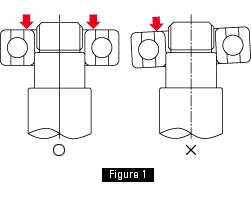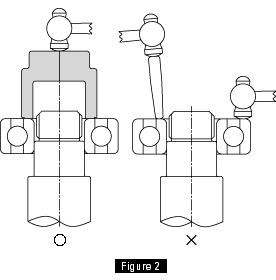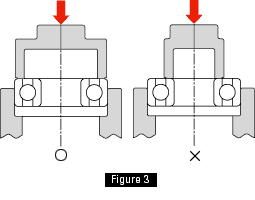
Performance, precision and service life heavily depend on whether bearings are mounted correctly, therefore it is important to mount them very carefully.
Precautions Before Mounting
Keep workshop clean
Ensure that the workbench and its surrounding are clean and tidy. Also ensure that the equipment on which the bearings are to be mounted is clean. Do not use rags or gloves soiled with sand, dirt or lint.
Check mounting dimensions and surface finish
To ensure proper mounting, it is important to check whether the shafts or housings precisely conform to the dimensions shown in the drawings. Also, ensure that fitting surfaces are free of indentation or burrs.
How to apply force
When applying force to bearings, always do so evenly and in parallel with shaft. Do not apply force when the bearing is at an angle, or the bearing would be damaged.

If a tool like a hammer is used to mount the bearings on the shaft, a jig should be employed as shown in Figure 2 to ensure that force is applied evenly in a straight line. It is also advisable to use a plastic hammer or the like to minimize the impact on the bearing.

When press fitting the outer ring of a bearing into a housing, a mounting tool should be placed on the outer ring as shown in the correct example of Figure 3. If the inner ring was pressed as shown in the incorrect example, the race ways and the ball surfaces of the bearings should be intended or scored.

Simultaneous press fitting of inner and outer rings
When press fitting the inner and outer rings at the same time, use a metal fitting as shown in Figure 4 and apply force using a press or a jack.


